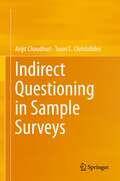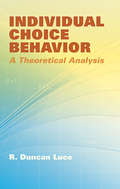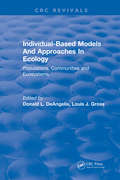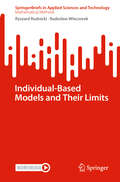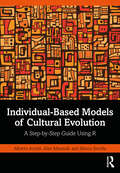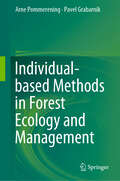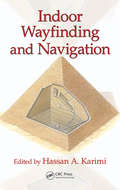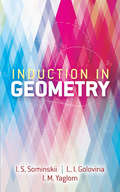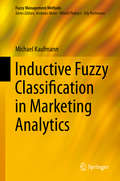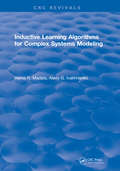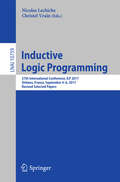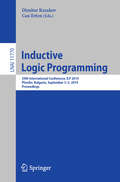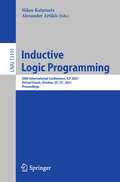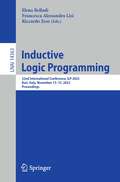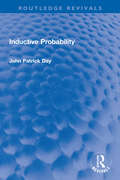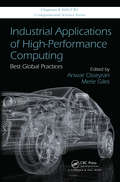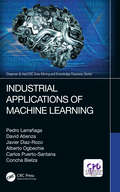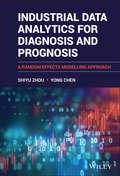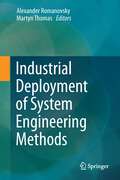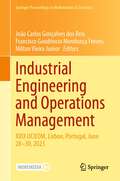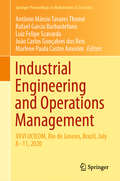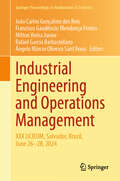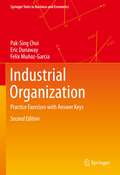- Table View
- List View
Indirect Questioning in Sample Surveys
by Tasos C. Christofides Arijit ChaudhuriIndirect questioning is a crucial topic in surveys of human populations. When the issue is about a stigmatizing characteristic (for example about illegal drug use), standard survey methodologies are destined to fail because, as expected, people are not willing to reveal incriminating information or information violating their privacy. Indirect questioning techniques have been devised so that the privacy of participants in a sample survey is protected and at the same time good estimates of certain parameters (e.g. the percentage of people in a certain community who use illegal drugs) can be delivered. The topic is modern and still under development. Indirect Questioning in Sample Surveys represents a collection of the most important and recent techniques of indirect questioning, including various versions of randomized response, the item count technique, the nominative technique, the three-card method, non-randomized response models and negative surveys, while also exploring the key aspect of protecting privacy.
Individual Choice Behavior: A Theoretical Analysis (Dover Books on Mathematics)
by R. Duncan LuceThis influential treatise presents upper-level undergraduates and graduate students with a mathematical analysis of choice behavior. It begins with the statement of a general axiom upon which the rest of the book rests; the following three chapters, which may be read independently of each other, are devoted to applications of the theory to substantive problems: psychophysics, utility, and learning.Applications to psychophysics include considerations of time- and space-order effects, the Fechnerian assumption, the power law and its relation to discrimination data, interaction of continua, discriminal processes, signal detectability theory, and ranking of stimuli. The next major theme, utility theory, features unusual results that suggest an experiment to test the theory. The final chapters explore learning-related topics, analyzing the stochastic theories of learning as the basic approach—with the exception that distributions of response strengths are assumed to be transformed rather than response probabilities. The author arrives at three classes of learning operators, both linear and nonlinear, and the text concludes with a useful series of appendixes.
Individual-Based Models and Approaches In Ecology: Populations, Communities and Ecosystems
by D. L. DeAngelisUntil fairly recently, populations were handled as homogenized averages, which made modeling feasible but which ignored the essential fact that in any population there is a great variety of individuals of different ages, sizes, and degrees of fitness. Recently, because of the increased availability of affordable computer power, approaches have been developed which are able to recognize individual differences. Individual-based models are of great use in the areas of aquatic ecology, terrestrial ecology, landscape or physiological ecology, terrestrial ecology, landscape or physiological ecology, and agriculture.This book discusses which biological problems individual-based models can solve, as well as the models' inherent limitations. It explores likely future directions of theoretical development in these models, as well as currently feasible management applications and the best mathematical approaches and computer languages to use. The book also details specific applications to theory and management.
Individual-Based Models and Their Limits (SpringerBriefs in Applied Sciences and Technology)
by Ryszard Rudnicki Radosław WieczorekIndividual-based models (IBM) describe a population as a collection of different organisms whose local interactions determine the behaviour of the entire population. The individual description is convenient for computer simulations and the determination of various model parameters, and appropriate limit passages lead to the transport equations used in classical population dynamics models. The aim of this book is to provide a brief mathematical introduction to IBMs and their application to selected biological topics. The book is divided into seven chapters. In the first chapter we give a general description of IBMs and we present examples of models to illustrate their possible applications. Examples of applications include age, size and phenotype models, coagulation-fragmentation process, and models of genome evolution. The second chapter contains some theoretical results concerning limit passages from IBMs to phenotype and age-structured models. The rate of this convergence formulated as functional central limit theorems is presented in Chapter 3. As a result of the limit passage can be a superprocess, i.e., a stochastic process with values in a space of measures. Chapter 4 presented examples of such passages: from the branching Brownian motion to the Dawson--Watanabe superprocess and from the Moran's model of genetic drift with mutations to the Fleming--Viot superprocess. The next three chapters are devoted to models, in which we directly participated in the study. In Chapter 5 we study IBMs phenotype models and their limit passages. We show that random mating stabilises the distribution of traits, while assortative mating can lead to a polymorphic population. Formation of aggregates of phytoplankton and their movement is studied in Chapter 6. We present two types of models based on: fragmentation-coagulation processes; and diffusion with chemical signals leading to advanced superprocesses. Chapter 7 is devoted to rather advanced models with chemotaxis used to description of retinal angiogenesis and cell proliferations. The book is complemented by two appendices in which we have collected information about stochastic processes and various spaces we have used. The book is dedicated both to mathematicians and biologists. The first group will find here new biological models which leads to interesting and often new mathematical questions. Biologists can observe how to include seemingly different biological processes into a unified mathematical theory and deduce from this theory interesting biological conclusions. Apart from the sections on superprocesses, where quite advanced mathematical issues arise, such as stochastic partial equations, we try to keep the required mathematical and biological background to a minimum so that the topics are accessible to students.
Individual-Based Models of Cultural Evolution: A Step-by-Step Guide Using R
by Alex Mesoudi Alberto Acerbi Marco SmollaIndividual-Based Models of Cultural Evolution shows readers how to create individual-based models of cultural evolution using the programming language R. The field of cultural evolution has emerged in the last few decades as a thriving, interdisciplinary effort to understand cultural change and cultural diversity within an evolutionary framework and using evolutionary tools, concepts, and methods. Given its roots in evolutionary biology, much of cultural evolution is grounded in, or inspired by, formal models. Yet many researchers interested in cultural evolution come from backgrounds that lack training in formal modelling, such as psychology, anthropology or archaeology. This book addresses that gap. It provides example code in R for readers to run their own models, moving from very simple models of the basic processes of cultural evolution, such as biased transmission and cultural mutation, to more advanced topics such as the evolution of social learning, demographic effects, and social network analysis. Features of this book: Recreates existing models in the literature to show how these were created and to enable readers to have a better understanding of their significance and how to apply them to their own research questions Provides full R code to realize models and analyse and plot outputs, with line-by-line analysis Requires no previous knowledge of the field of cultural evolution, and only very basic programming knowledge This is an essential resource for researchers and students interested in cultural evolution, including disciplines such as psychology, anthropology, archaeology, and biology as well as sociology and digital humanities.
Individual-based Methods in Forest Ecology and Management
by Arne Pommerening Pavel GrabarnikModel-driven individual-based forest ecology and individual-based methods in forest management are of increasing importance in many parts of the world. For the first time this book integrates three main fields of forest ecology and management, i.e. tree/plant interactions, biometry of plant growth and human behaviour in forests. Individual-based forest ecology and management is an interdisciplinary research field with a focus on how the individual behaviour of plants contributes to the formation of spatial patterns that evolve through time. Key to this research is a strict bottom-up approach where the shaping and characteristics of plant communities are mostly the result of interactions between plants and between plants and humans. This book unites important methods of individual-based forest ecology and management from point process statistics, individual-based modelling, plant growth science and behavioural statistics. For ease of access, better understanding and transparency the methods are accompanied by R code and worked examples.
Indoor Wayfinding and Navigation
by Hassan A. KarimiDue to the widespread use of navigation systems for wayfinding and navigation in the outdoors, researchers have devoted their efforts in recent years to designing navigation systems that can be used indoors. This book is a comprehensive guide to designing and building indoor wayfinding and navigation systems. It covers all types of feasible sensors (for example, Wi-Fi, A-GPS), discussing the level of accuracy, the types of map data needed, the data sources, and the techniques for providing routes and directions within structures.
Induction in Geometry (Dover Books on Mathematics)
by L.I. Golovina I. M. YaglomInduction in Geometry discusses the application of the method of mathematical induction to the solution of geometric problems, some of which are quite intricate. The book contains 37 examples with detailed solutions and 40 for which only brief hints are provided. Most of the material requires only a background in high school algebra and plane geometry; chapter six assumes some knowledge of solid geometry, and the text occasionally employs formulas from trigonometry. Chapters are self-contained, so readers may omit those for which they are unprepared. To provide additional background, this volume incorporates the concise text, The Method of Mathematical Induction. This approach introduces this technique of mathematical proof via many examples from algebra, geometry, and trigonometry, and in greater detail than standard texts. A background in high school algebra will largely suffice; later problems require some knowledge of trigonometry. The combination of solved problems within the text and those left for readers to work on, with solutions provided at the end, makes this volume especially practical for independent study.
Inductive Fuzzy Classification in Marketing Analytics
by Michael KaufmannTo enhance marketing analytics, approximate and inductive reasoning can be applied to handle uncertainty in individual marketing models. This book demonstrates the use of fuzzy logic for classification and segmentation in marketing campaigns. Based on practical experience as a data analyst and on theoretical studies as a researcher, the author explains fuzzy classification, inductive logic and the concept of likelihood and introduces a blend of Bayesian and Fuzzy Set approaches, allowing reasonings on fuzzy sets that are derived by inductive logic. By application of this theory, the book guides the reader towards a gradual segmentation of customers which can enhance return on targeted marketing campaigns. The algorithms presented can be used for visualization, selection and prediction. The book shows how fuzzy logic can complement customer analytics by introducing fuzzy target groups. This book is for researchers, analytics professionals, data miners and students interested in fuzzy classification for marketing analytics.
Inductive Learning Algorithms for Complex Systems Modeling
by H.R. MadalaInductive Learning Algorithms for Complex Systems Modeling is a professional monograph that surveys new types of learning algorithms for modeling complex scientific systems in science and engineering. The book features discussions of algorithm development, structure, and behavior; comprehensive coverage of all types of algorithms useful for this subject; and applications of various modeling activities (e.g., environmental systems, noise immunity, economic systems, clusterization, and neural networks). It presents recent studies on clusterization and recognition problems, and it includes listings of algorithms in FORTRAN that can be run directly on IBM-compatible PCs. Inductive Learning Algorithms for Complex Systems Modeling will be a valuable reference for graduate students, research workers, and scientists in applied mathematics, statistics, computer science, and systems science disciplines. The book will also benefit engineers and scientists from applied fields such as environmental studies, oceanographic modeling, weather forecasting, air and water pollution studies, economics, hydrology, agriculture, fisheries, and time series evaluations.
Inductive Logic Programming: 27th International Conference, Ilp 2017, Orléans, France, September 4-6, 2017, Revised Selected Papers (Lecture Notes in Computer Science #10759)
by Nicolas Lachiche Christel VrainThis book constitutes the thoroughly refereed post-conference proceedings of the 27th International Conference on Inductive Logic Programming, ILP 2017, held in Orléans, France, in September 2017. The 12 full papers presented were carefully reviewed and selected from numerous submissions. Inductive Logic Programming (ILP) is a subfield of machine learning, which originally relied on logic programming as a uniform representation language for expressing examples, background knowledge and hypotheses. Due to its strong representation formalism, based on first-order logic, ILP provides an excellent means for multi-relational learning and data mining, and more generally for learning from structured data.
Inductive Logic Programming: 29th International Conference, ILP 2019, Plovdiv, Bulgaria, September 3–5, 2019, Proceedings (Lecture Notes in Computer Science #11770)
by Dimitar Kazakov Can ErtenThis book constitutes the refereed conference proceedings of the 29th International Conference on Inductive Logic Programming, ILP 2019, held in Plovdiv, Bulgaria, in September 2019. The 11 papers presented were carefully reviewed and selected from numerous submissions. Inductive Logic Programming (ILP) is a subfield of machine learning, which originally relied on logic programming as a uniform representation language for expressing examples, background knowledge and hypotheses. Due to its strong representation formalism, based on first-order logic, ILP provides an excellent means for multi-relational learning and data mining, and more generally for learning from structured data.
Inductive Logic Programming: 30th International Conference, ILP 2021, Virtual Event, October 25–27, 2021, Proceedings (Lecture Notes in Computer Science #13191)
by Alexander Artikis Nikos KatzourisThis book constitutes the refereed conference proceedings of the 30th International Conference on Inductive Logic Programming, ILP 2032, held in October 2021. Due to COVID-19 pandemic the conference was held virtually. The 16 papers and 3 short papers presented were carefully reviewed and selected from 19 submissions. Inductive Logic Programming (ILP) is a subfield of machine learning, which originally relied on logic programming as a uniform representation language for expressing examples, background knowledge and hypotheses. Due to its strong representation formalism, based on first-order logic, ILP provides an excellent means for multi-relational learning and data mining, and more generally for learning from structured data.
Inductive Logic Programming: 32nd International Conference, ILP 2023, Bari, Italy, November 13–15, 2023, Proceedings (Lecture Notes in Computer Science #14363)
by Elena Bellodi Riccardo Zese Francesca Alessandra LisiThis book constitutes the refereed proceedings of the 32nd International Conference on Inductive Logic Programming, ILP 2023, held in Bari, Italy, during November 13–15, 2023.The 11 full papers and 1 short paper included in this book were carefully reviewed and selected from 18 submissions. They cover all aspects of learning in logic, multi-relational data mining, statistical relational learning, graph and tree mining, learning in other (non-propositional) logic-based knowledge representation frameworks, exploring intersections to statistical learning and other probabilistic approaches.
Inductive Probability (Routledge Revivals)
by J. P. DayFirst published in 1961, Inductive Probability is a dialectical analysis of probability as it occurs in inductions. The book elucidates on the various forms of inductive, the criteria for their validity, and the consequent probabilities. This survey is complemented with a critical evaluation of various arguments concerning induction and a consideration of relation between inductive reasoning and logic. The book promises accessibility to even casual readers of philosophy, but it will hold particular interest for students of Philosophy, Mathematics and Logic.
Industrial Applications of High-Performance Computing: Best Global Practices
by Anwar Osseyran Merle GilesIndustrial Applications of High-Performance Computing: Best Global Practices offers a global overview of high-performance computing (HPC) for industrial applications, along with a discussion of software challenges, business models, access models (e.g., cloud computing), public-private partnerships, simulation and modeling, visualization, big data a
Industrial Applications of Machine Learning (Chapman & Hall/CRC Data Mining and Knowledge Discovery Series)
by Pedro Larrañaga David Atienza Javier Diaz-Rozo Alberto Ogbechie Concha Bielza Carlos Esteban Puerto-SantanaIndustrial Applications of Machine Learning shows how machine learning can be applied to address real-world problems in the fourth industrial revolution, and provides the required knowledge and tools to empower readers to build their own solutions based on theory and practice. The book introduces the fourth industrial revolution and its current impact on organizations and society. It explores machine learning fundamentals, and includes four case studies that address a real-world problem in the manufacturing or logistics domains, and approaches machine learning solutions from an application-oriented point of view. The book should be of special interest to researchers interested in real-world industrial problems. <P><P>Features <li>Describes the opportunities, challenges, issues, and trends offered by the fourth industrial revolution <li>Provides a user-friendly introduction to machine learning with examples of cutting-edge applications in different industrial sectors <li>Includes four case studies addressing real-world industrial problems solved with machine learning techniques <li>A dedicated website for the book contains the datasets of the case studies for the reader's reproduction, enabling the groundwork for future problem-solving <li>Uses of three of the most widespread software and programming languages within the engineering and data science communities, namely R, Python, and Weka
Industrial Data Analytics for Diagnosis and Prognosis: A Random Effects Modelling Approach
by Yong Chen Shiyu ZhouDiscover data analytics methodologies for the diagnosis and prognosis of industrial systems under a unified random effects model In Industrial Data Analytics for Diagnosis and Prognosis - A Random Effects Modelling Approach, distinguished engineers Shiyu Zhou and Yong Chen deliver a rigorous and practical introduction to the random effects modeling approach for industrial system diagnosis and prognosis. In the book’s two parts, general statistical concepts and useful theory are described and explained, as are industrial diagnosis and prognosis methods. The accomplished authors describe and model fixed effects, random effects, and variation in univariate and multivariate datasets and cover the application of the random effects approach to diagnosis of variation sources in industrial processes. They offer a detailed performance comparison of different diagnosis methods before moving on to the application of the random effects approach to failure prognosis in industrial processes and systems. In addition to presenting the joint prognosis model, which integrates the survival regression model with the mixed effects regression model, the book also offers readers: A thorough introduction to describing variation of industrial data, including univariate and multivariate random variables and probability distributions Rigorous treatments of the diagnosis of variation sources using PCA pattern matching and the random effects model An exploration of extended mixed effects model, including mixture prior and Kalman filtering approach, for real time prognosis A detailed presentation of Gaussian process model as a flexible approach for the prediction of temporal degradation signals Ideal for senior year undergraduate students and postgraduate students in industrial, manufacturing, mechanical, and electrical engineering, Industrial Data Analytics for Diagnosis and Prognosis is also an indispensable guide for researchers and engineers interested in data analytics methods for system diagnosis and prognosis.
Industrial Deployment of System Engineering Methods
by Martyn Thomas Alexander RomanovskyA formal method is not the main engine of a development process, its contribution is to improve system dependability by motivating formalisation where useful. This book summarizes the results of the DEPLOY research project on engineering methods for dependable systems through the industrial deployment of formal methods in software development. The applications considered were in automotive, aerospace, railway, and enterprise information systems, and microprocessor design. The project introduced a formal method, Event-B, into several industrial organisations and built on the lessons learned to provide an ecosystem of better tools, documentation and support to help others to select and introduce rigorous systems engineering methods. The contributing authors report on these projects and the lessons learned. For the academic and research partners and the tool vendors, the project identified improvements required in the methods and supporting tools, while the industrial partners learned about the value of formal methods in general. A particular feature of the book is the frank assessment of the managerial and organisational challenges, the weaknesses in some current methods and supporting tools, and the ways in which they can be successfully overcome. The book will be of value to academic researchers, systems and software engineers developing critical systems, industrial managers, policymakers, and regulators.
Industrial Design of Experiments: A Case Study Approach for Design and Process Optimization
by Sammy ShinaThis textbook provides the tools, techniques, and industry examples needed for the successful implementation of design of experiments (DoE) in engineering and manufacturing applications. It contains a high-level engineering analysis of key issues in the design, development, and successful analysis of industrial DoE, focusing on the design aspect of the experiment and then on interpreting the results. Statistical analysis is shown without formula derivation, and readers are directed as to the meaning of each term in the statistical analysis. Industrial Design of Experiments: A Case Study Approach for Design and Process Optimization is designed for graduate-level DoE, engineering design, and general statistical courses, as well as professional education and certification classes. Practicing engineers and managers working in multidisciplinary product development will find it to be an invaluable reference that provides all the information needed to accomplish a successful DoE.
Industrial Engineering and Industrial Management: 5th International Conference, IEIM 2024, Nice, France, January 10–12, 2024, Proceedings (Communications in Computer and Information Science #2070)
by Shey-Huei SheuThis CCIS post conference volume constitutes the proceedings of the 5th International Conference, IEIM 2024, in Nice, France, in January 2024. The 18 full papers together with 3 short papers in this volume were carefully reviewed and selected from 71 submissions. The were organized in 5 tracks as follows: five topics of IEIM were classified as follows: “Data Analysis and Demand Calculation in Industrial Production”, “Process Optimization and Intelligence in Green Manufacturing Systems”, “Lean Manufacturing and Process Optimization”, “Enterprise Digital Transformation and Business Management” and “Modern Logistics Information Systems and Distribution Services”.
Industrial Engineering and Operations Management: XXIX IJCIEOM, Lisbon, Portugal, June 28–30, 2023 (Springer Proceedings in Mathematics & Statistics #431)
by Milton Vieira Junior João Carlos Gonçalves dos Reis Francisco Gaudêncio Mendonça FreiresThis proceedings volume gathers selected, blinded peer-reviewed contributions presented at the XXIX International Joint Conference on Industrial Engineering and Operations Management (IJCIEOM), held in Lisbon, Portugal, from June 28th to 30th, 2023. This volume focuses especially on the applications of Industrial Engineering and Operations Management for research and practice. It includes relevant information for academics since most of the chapters focus on real-world case studies and systematic reviews. It also provides valuable insights for professionals in the industrial sector by presenting solutions to complex industrial challenges. The 2023 iteration of the IJCIEOM conference had the theme "Developing resilience in Industrial Engineering and Operations Management" and aimed to analyze the resilience of supply chains in the post-COVID-19 era. The works published in this volume focus on how Digital Transformation (DX) and Artificial Intelligence (AI) have made the manufacturing and service industry more resistant to VUCA elements (i.e., volatile, uncertain, complex, and ambiguous). Regarding DX and AI, the research specifically focused on supply chain management, project management, and Industry 4.0. Other studies explore how industrial engineering incorporated innovative and technological concepts into service and product operations. Overall, this volume provides a valuable resource for researchers and practitioners alike as it presents numerous relevant contributions in identifying new challenges and opportunities for industrial engineering and operations management. This conference was sponsored by renowned international industry engineering associations, particularly the American Society for Engineering Management (ASEM), the Institute of Industrial & Systems Engineers (IISE), and the Asociación para el Desarrollo de la Ingeniería de Organización (ADINGOR).
Industrial Engineering and Operations Management: XXVI IJCIEOM, Rio de Janeiro, Brazil, July 8–11, 2020 (Springer Proceedings in Mathematics & Statistics #337)
by Antônio Márcio Tavares Thomé Rafael Garcia Barbastefano Luiz Felipe Scavarda João Carlos Gonçalves dos Reis Marlene Paula Castro AmorimThis volume gathers selected peer-reviewed papers presented at the XXVI International Joint Conference on Industrial Engineering and Operations Management (IJCIEOM), held on July 8-11, 2020 in Rio de Janeiro, Brazil. The respective chapters address a range of timely topics in industrial engineering, including operations and process management, global operations, managerial economics, data science and stochastic optimization, logistics and supply chain management, quality management, product development, strategy and organizational engineering, knowledge and information management, work and human factors, sustainability, production engineering education, healthcare operations management, disaster management, and more. These topics broadly involve fields like operations, manufacturing, industrial and production engineering, and management. Given its scope, the book offers a valuable resource for those engaged in optimization research, operations research, and practitioners alike.
Industrial Engineering and Operations Management: XXX IJCIEOM, Salvador, Brazil, June 26–28, 2024 (Springer Proceedings in Mathematics & Statistics #483)
by Milton Vieira Junior Rafael Garcia Barbastefano João Carlos Gonçalves dos Reis Francisco Gaudêncio Mendonça Freires Ângelo Márcio Oliveira Sant’AnnaThis proceedings gathers selected, peer-reviewed papers presented at the XXX International Joint Conference on Industrial Engineering and Operations Management (IJCIEOM), held from June 26 to 28, 2024, in Salvador, Brazil. The works in this volume explores critical areas such as Supply Chain risk models, last-mile delivery optimization, stochastic inventory models, and human development focusing on digital training for operations management in emergencies. Tailored to benefit academics, the volume comprises studies predominantly rooted in real-world case studies, systematic, and meta-reviews, offering valuable insights also for professionals within the industrial sector by presenting solutions to intricate industrial challenges.
Industrial Organization: Practice Exercises with Answer Keys (Springer Texts in Business and Economics)
by Pak-Sing Choi Eric Dunaway Felix Muñoz-GarciaRevised and updated for the second edition, this textbook presents over 100 exercises on industrial organization with detailed answer keys. While most textbooks on industrial organization focus on theory and empirical findings, this textbook offers practical examples and exercises helping predict firm behavior in different industries. The book emphasizes the game-theoretic tools used in each type of exercise, so students can systematically apply them to other markets, forms of competition, or information environments where firms, consumers, and regulating agencies interact. The book begins with examples that analyze different models of firm behavior and interaction; starting with monopoly and moving through the Cournot model of simultaneous quantity competition, the Bertrand model simultaneous price competition, and sequential competition. The following chapters apply game-theoretic tools to situations of increasing complexity: regulation; R&D incentives; mergers and collusion; bundling incentives; incomplete information, signaling, and competition; networks and switching costs. In addition to providing algebraic simplifications, some chapters also offer the unique feature of worked exercises based on published journal articles by leading scholars in the field. Finally, exercises are ranked according to their difficulty, with a letter (A-C) next to the exercise number, which allows students to pace their studies and instructors to structure their classes accordingly. The second edition contains additional exercises optimized for study at the upper undergraduate level. Providing a rigorous, yet practical introduction to the field of industrial organization, this textbook is appropriate for advanced undergraduate and graduate students in economics and finance.
